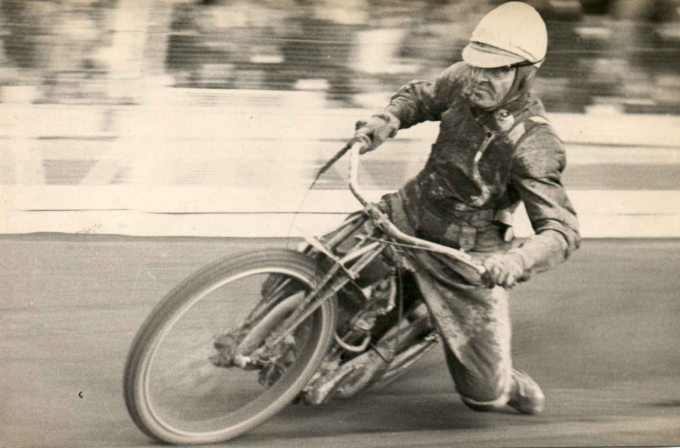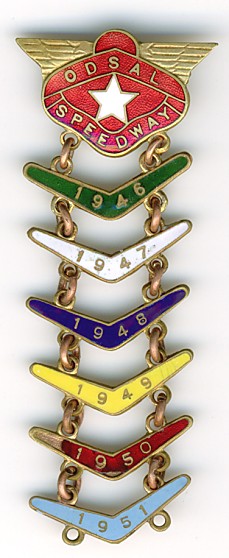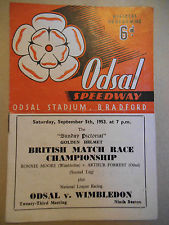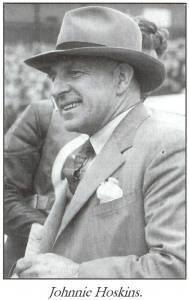
By Ian Hemmens
Great Britain in 1945, a country battered by 6 years of war despite the final victory. The euphoria of the victory was also tempered by a weariness brought on by the conflict and the effect of rationing. As the country saw the daylight again, things had changed. People wanted to be entertained again. Picture houses opened by the score and theatres also saw record attendances. Sports of all kinds saw record attendances as the public finely tried to leave the dark days behind.
In Bradford, City had struggled through the war years, only the hard work of Cllr Bob Sharp keeping the club alive. Park Avenue fared a lot better with several players introduced who would become household names like Len Shackleton, Chick Farr & the like. In Rugby League, Bradford Northern were about to enter a Golden Age with success in the league but especially in the Challenge Cup with 5 finals appearances & 3 victories.
Along with 2 greyhound stadiums and also Bradford RU at Lidget Green the City was well served for sporting choice but another sport appeared which was due to boom appeared on the scene to compete with the rest.
Bradford Northern Managing Director Harry Hornby had explored the idea of bringing Speedway to Odsal Stadium in the 1930s to help the financially strapped RL team as the sport took off but nothing came of it until legendary promoter Johnnie Hoskins came on the scene and saw the huge potential of the massive bowl.
With encouragement from the authorities, Hoskins began developing the track but as the whole country were still operating under Wartime measures, procuring materials proved difficult and the ingenuity of the band of volunteers proved that anything can be achieved with determination. The track lights were old motor car headlamps from local scrap yards as was most of the wiring for a basic public address system.
A massive campaign of publicity was undertaken plastering Northern cities & towns about the new Speedway track and Johnnie Hoskins badgered newspapers for much needed column space. Remember we were still at War with Japan, newsprint was scarce & restricted, the established sports journalists jealously guarded their own column inches yet his persistence paid off with June 23rd 1945 seeing a huge 20000 crowd filling Odsal for the first Speedway meeting featuring 16 of the countries best riders competing for a trophy named the A. J. Elvin Cup.
All proceeds were to be given to the British Legion which obviously helped the cause of getting fans through the turnstiles. The crowd was a mixture of Motorcycle fans and curious observers of this new sport to Bradford.
The riders had accepted the invitation without even a trial run on the new track and of course as the 1st heat roared into life there was an almighty pile up at the first corner thankfully with no injuries. A restart saw the riders show more respect to the sharp turns and Colin Watson had the honour of winning the 1st ever heat of Speedway at Odsal.
In 1945, West Ham rider Ernie Price was the big star but the Meet was won by Wilf Jay with 14 points. As modifications were made to the track, the National League had not yet been started and the Odsal team was made up of riders who accepted invitations to ride in Challenge Meets against established teams.
The charm and gift of the gab of Hoskins saw that Odsal began to attract big meets to the stadium. The British Championship was followed by an England vs Australia fixture attracting the biggest stars in the sport and crowds of under 20000 were a rarity at Odsal in those pioneering early days. That first British Championship saw 2 names destined for greater things in Bradford Speedway folklore in ‘leg trailer’ Oliver Hart & Ron Clarke whilst the track record was continually smashed as riders became more familiar & more daring with the track. First Ernie Price, then Wilf Jay followed by Bill Kitchen lowered the time in quick succession
1946 saw the establishment of the National League and the Odsal Boomerangs entered the the 6 team league with the Manchester based Belle Vue Aces club flying the flag for the North against 4 London based clubs in Wembley Lions, West Ham Hammers, Wimbledon Dons & the New Cross Rangers.
All was going well with the team challenging at the top when on the night of July 6th, tragedy struck in a challenge meet with Belle Vue. Huddersfield rider Albert ‘Aussie’ Rosenfeld hit the back wheel of ‘Aces’ Harold Jackson and was thrown head first into the wall. He died within a fortnight of a fractured skull and 7 days later Colin Watson also fractured his skull but thankfully lived despite never riding again.
The Control Board authorities demanded changes to the track immediately with the threat of the license being withdrawn. The track was reduced and corners curved more to produce smoother riding and the 1st season saw the Boomerangs finish a highly creditable 3rd place behind Wembley & Belle Vue. A reserve side was also introduced to develop local talent.

1947 saw several significant signings with Oliver Hart, Ron Clarke, Joe Abbott & Eddie Rigg becoming household names over the years. The year was a season of consolidation after the euphoria of the first year and a mid table finish was acceptable for the developing team. Bruce Booth became team manager as Johnnie Hoskins concentrated on promoting the team nationwide in a bid to attract the best riders and meetings to the stadium.
Despite the promise, 1948 was a disaster with injury problems, lack of a proper heat leader & contract troubles all causing a ‘wooden spoon’ finish after a shocking away record. The team lost their top 2 riders for weeks on end both Grosskreutz & Hart suffering from concussion after collisions & the juniors brought in just weren’t up to the standard.
1949 saw the departure of Johnnie Hoskins as promoter with Bruce Booth taking over duties and mechanical wizard Eric Langton coming in on the ‘coal face’ as liaison between the riders & management. Ron Clarke became Captain, Jack Biggs was signed to take over from the retiring Max Grosskreutz brought a more solid look to the team and they recovered from the last place of the year before to finish half way in the table suffering only 2 home defeats all season, a big improvement.
The new decade saw change, the Boomerangs became the Tudors, a threatened riders strike over the tyre thickness which they thought compromised their safety was averted when the Control Board backed down. Injuries continued to jinx the team with Biggs, Seers & ‘hard man’ Joe Abbott all affected. Another mid table finish was adequate although worryingly, crowds were down averaging under 20000 for the 1st time but none of this really mattered as on July1st, tragedy struck once again as veteran rider and huge favourite Joe Abbott was killed after hitting his head on the track dying instantly.
In what was a black night for speedway, 150 miles away at the Norwich track, former Boomerang Jock Shead riding for the new Halifax team was also killed in a track crash. Joe Abbott was a huge loss to the team, at 48 years old, the father of the team & a huge presence in the pits as well as a consistent points scorer.
1951 saw newcomers Arthur Wright, Dent Oliver, Arthur Bush & £500 signing Lloyd Goffe join the team with Eddie Rigg taking over the Captaincy after Ron Clarke broke his leg. Bruce Booth lost his trusty lieutenant Eric Langton who moved to Sheffield and the change in name brought little luck as the team slumped to the foot of the National League once again.

The next season saw a marginal improvement with exciting newcomers Arthur Forrest, known as the ‘Black Prince’ due to his immaculate leathers and Keith Milner from the juniors but the injury jinx struck again when legendary leg trailer Oliver Hart crashed at Owlerton fracturing ribs, breaking his back and being carried unconscious from the track, his great career was over. Tragedy also hit Promoter Bruce Booth when his wife was killed in a car crash. No better tribute to Harts status in the sport was the one from Sir Malcolm Campbell of ‘Bluebird’ fame who said Hart was the most exciting rider he had ever seen.
1953 saw fortunes change for the better as the youngsters took the lead with the 2 Arthurs, Wright & Forrest showing their rich promise. Forrest along with team mate Dent Oliver qualified for the individual World Final for the first time, a proud moment for both riders and the team. In Coronation year, the Tudors had new heroes as Arthur Wright broke the track record and Forrest established himself as one of the sports new stars by also gaining recognition by being capped for England & with Milner continuing his progress a great 4th place finish was achieved only spoilt slightly but 2 home defeats which cost a 2nd place finish.
Things were looking up after several years of problems with the fresh young team showing huge promise at last. The following year saw the progress continue with a record mauling of the Birmingham side 65-19 being the highlight. Bruce Booth had introduced Monday night training schools for promising youngsters and the emergence of Wright & Milner were evidence of the success of this venture hopefully producing a line of talent ready to step up when needed. Wimbledon legend stole Arthur Wrights track record but the Tudors finished an all time high of 3rd place with only 1 home defeat all season, their poor away form putting paid to any title challenge.
The season of ’55 saw the usual poor away form costing the team the chance of any real glory and the injury jinx returned with young Keith Milner being put out for the season after a crash on the track. Another 4th place finish led by England stars Wright & Forrest was decent considering. Arthur Forrest also won the treasured Golden Helmet at Birmingham against Wembley’s Eric Williams in a race-off. Youngster Des Haswell was also badly injured which gave a name of the future, 18 year old Nigel Boocock his 1st team debut.
The year 1956 saw the end of an era when at the end of the season the Odsal Tudors hit rock bottom again, dwindling crowds and other attractions brought financial problems. A management fall out saw Bruce Booth leave and a group of riders take over the promoting duties. This all led to the team being with drawn from the national league.
Despite Arthur Forrest finishing an all time best 3rd in the World Championships, the team as a whole had a huge drop off in performance. Several more youngsters were tried and forgive me here for a small personal indulgence as one of the youngsters Johnny Greenwood who made several 1st team appearances had my late Uncle Billy Chalkley as his mechanic as they were mates and Billy was stationed in Edinburgh when Johnny moved up there to join the Monarchs when the Tudors faded out of the scene.
It was the end of an era and although they returned as Bradford Tudors in late 57 replacing Birmingham, it was a one season event until Speedway returned once again as the Bradford Panthers in 1959 but that’s another story.
The names of Forrest, Wright, Rigg, Hart, Clarke & their teammates are remembered fondly by a Bradford public who supported them fanatically at times following them the length & breadth of the country to meetings. My Mother & Uncle were members of the Keighley Branch who travelled everywhere by motorbike this in the years before motorway. One week Edinburgh, the next week Wembley. They had caught the bug from my Grandad who was a fan in the 30s of true pioneers like ‘Sprouts’ Elder, the American showman & leg trailer. My Grandad was a despatch rider in the WW2 so bikes were a familiar site in our family & this passed on to me when Speedway was introduced once again in the early 70s to the Odsal bowl as Bradford Northern.
Great days were to follow as the Dukes arrived in the 90s with wonderful riders like Carter, Loram, Screen & of course Havelock but these were stars for a new generation. They would write their own story and enter into the folklore of Bradford Speedway.


Well remember some of my earlier years going to watch the Boomerangs. Oliver Hart, Ernie Price , Ron Clarke , Joe Abbot . Regularly on a Saturday night. Had the badge plus two boomerangs ., I’m now 85 years old ,Often when we sat in Dads allotment and hen pen we could hear the races and sometimes the public address comment ,in Little Horton , Happy days .
LikeLike
Good read Ian . As you say there is another chapter , even before the Dukes migrated. The era when the Nelson team , lock stock and barrel came over to grace Odsal. That’s when I started going. Great times even travelling to away fixtures inc Eastbourne! It’s odd I know but lost interest in Speedway when Gary Peterson was tragically called. Again well done and thank you.
Kev
LikeLike
Bill Walsh. You still ok?
LikeLike
Well encapsulated Ian. Gives the real feel of Saturday nights at Odsal Top. I caught the speedway bug from my Dad’s collection of programmes from the era, went to the Shay and worked at Odsal from 1970 opening night v. Eastbourne. Happy days.
LikeLike
Hi Bill, good to hear from you Glad you enjoyed the article, i’d love a photo of Johnny for Mum, Thanks a lot. Keep well, all the best.
LikeLike
Well done Ian. What a nice surprise I had when I clicked on your new link. Your article is well researched and written. I can now see why you have been a bit quiet on the message board in recent times. You prompted me to dig out my box of tricks and pull out my Odsal Boomerangs supporters badge. It is not in such condition as yours but I have three more Boomerang date bars! 52/53/54. I saw John again when I made a quick visit 2 years ago and have a photo. Would you like a copy for your mother? Cheers
Bill
LikeLike